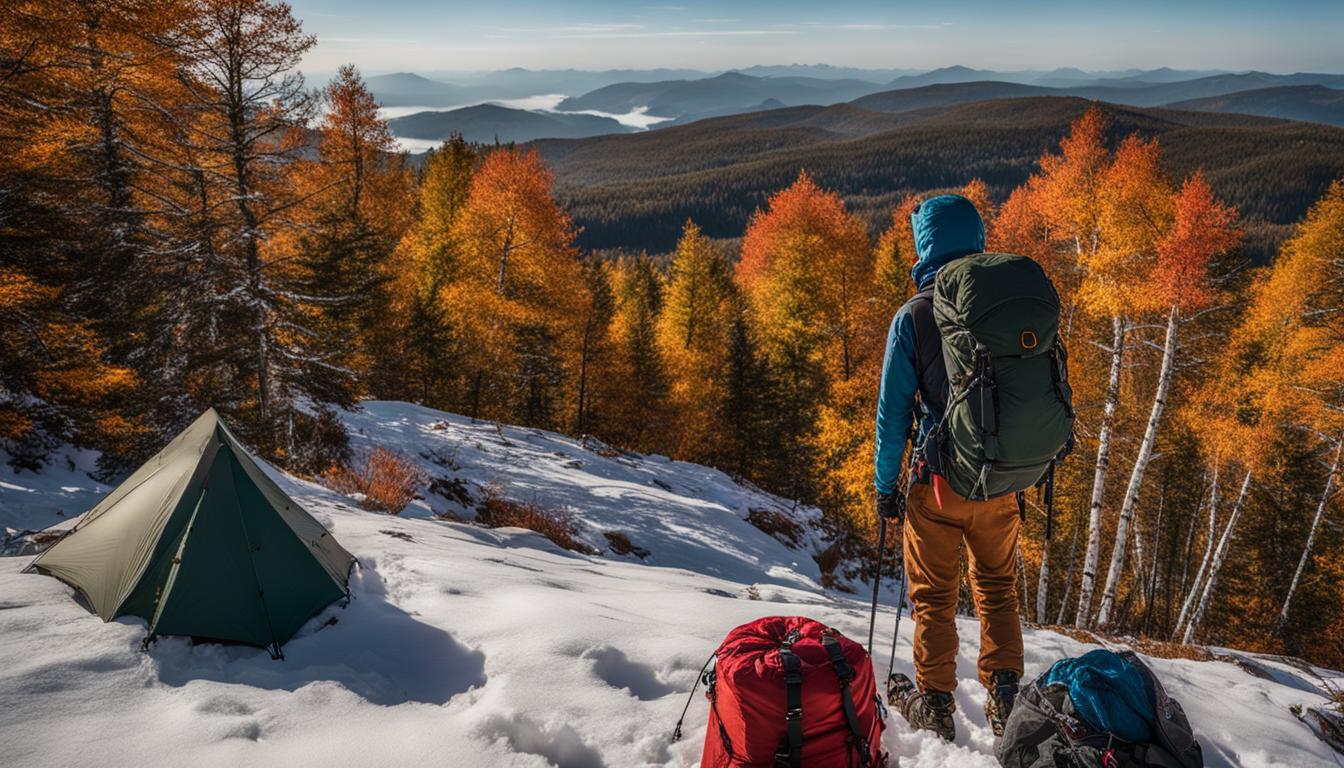When it comes to backpacking, having the right gear is crucial for a successful and enjoyable outdoor adventure. But did you know that it’s equally important to adapt your gear for the different seasons? By doing so, you can ensure that you are well-prepared to tackle any weather conditions that come your way.
Whether you’re venturing out in the scorching heat of summer or braving the freezing temperatures of winter, here are some valuable tips and considerations for selecting the appropriate gear for each season:
Key Takeaways:
- Take into account the specific weather conditions of the season you’ll be backpacking in.
- Consider the weight and compactness of your gear, as it can vary depending on the season.
- Select appropriate clothing and footwear to ensure comfort and protection.
- Invest in a reliable sleep system that suits the temperature range of the season.
- Don’t forget to pack essential items such as navigation tools, first aid kit, and emergency supplies.
By keeping these key takeaways in mind and adapting your backpacking gear accordingly, you’ll be well-prepared to face the challenges and make the most of your outdoor adventures in any season.
The importance of a good sleep system for backpacking in different seasons
When it comes to backpacking in different seasons, having a good sleep system is essential for a comfortable and restful night’s sleep. The right sleep system consists of various components that work together to provide insulation, comfort, and protection from the elements.
Sleeping Pad
A sleeping pad is an essential part of your sleep system as it provides insulation and cushioning between you and the ground. In colder seasons, it’s important to choose a pad with a higher R-value to keep you warm. Look for pads with insulation, such as foam or down fill, and consider the thickness and weight for your specific needs.
Sleeping Bag
Your sleeping bag is another crucial element of your sleep system. Choose a bag with a temperature rating appropriate for the season you’ll be backpacking in. For colder seasons, opt for a bag with a lower temperature rating to ensure warmth. Consider the bag’s insulation type, weight, and compactness for ease of carrying.
Shelter
Having a reliable shelter is essential for protecting yourself from the elements, such as rain, wind, and cold temperatures. Depending on the season, you may choose a tent, hammock, or bivy sack. Consider factors like weight, durability, weather resistance, and ease of setup when selecting your shelter.
| Component | Considerations |
|---|---|
| Sleeping Pad | Insulation, R-value, thickness, weight |
| Sleeping Bag | Temperature rating, insulation type, weight, compactness |
| Shelter | Weight, durability, weather resistance, ease of setup |
By carefully considering and selecting each component of your sleep system, you can ensure a comfortable and restful night’s sleep no matter the season. Remember to test your gear before your backpacking trip to familiarize yourself with its features and ensure that everything is in proper working order. With a good sleep system in place, you’ll be ready to tackle the challenges of backpacking in different seasons and enjoy the beauty of nature to the fullest.
How can I adapt my backpacking gear for different climates and seasons?
When it comes to backpacking gear essentials climates, versatility is key. Look for lightweight, moisture-wicking clothing for hot climates, and layer up with insulating pieces for cold weather. A good quality sleeping bag and tent are must-haves for any season. Research your destination’s climate and adjust your gear accordingly.
Conclusion
After exploring the importance of adapting backpacking gear for different seasons and understanding the key components of a good sleep system, it’s clear that proper gear selection is crucial for a successful outdoor adventure. By taking into account the specific weather conditions, using suitable clothing and footwear, and investing in high-quality gear, you can ensure that you are well-prepared to conquer nature.
Remember to layer your clothing appropriately, as this allows you to adjust your outfit according to the temperature fluctuations throughout the day. Protecting yourself from the sun and rain is also essential, so don’t forget to pack a hat, sunglasses, and a waterproof jacket.
Additionally, selecting the right sleep system and shelter is vital for a restful night’s sleep. Invest in a reliable sleeping pad and a well-insulated sleeping bag that is suited for the temperatures you anticipate encountering. A sturdy and waterproof shelter will provide you with the necessary protection from the elements.
By following these backpacking tips and adapting your gear for each season, you can embark on your outdoor adventures with confidence. So, gear up, embrace the challenges, and make the most of your backpacking experiences in every season!

